Staying compliant with current medical billing and coding practices is vital for healthcare entities to reduce claim errors, avoid any potential legal and financial risks, and thus ensure accurate reimbursement. Adhering to standard practices involves staying abreast of updates and changes in coding guidelines, payer policies, and regulatory requirements issued by entities such as the Centers for Medicare & Medicaid Services (CMS), the American Medical Association (AMA), and other relevant governing bodies. This includes staying informed about changes to code sets, such as the International Classification of Diseases (ICD), Current Procedural Terminology (CPT), and Healthcare Common Procedure Coding System (HCPCS), as well as updates to documentation and billing requirements. Medical billing and coding outsourcing is a great solution for providers to enhance their revenue cycle management strategies.

Medical Billing and Coding Compliance Tips
- Thorough staff training: Billing and coding staff must be provided thorough training and ongoing education, to ensure they are well-versed in coding guidelines, documentation requirements, and compliance regulations. For example, offer specialized training programs tailored to the specific needs of your staff, covering topics such as ICD-10-CM/PCS coding, CPT coding, medical terminology, and insurance verification procedures. These programs can provide in-depth knowledge and practical skills essential for accurate coding and billing. Software familiarity must be another important component of the training program because the trainees must understand how to use interfaces, enter data and generate claims accurately. The training on compliance and regulations must cover various legal and ethical considerations including HIPAA compliance, proper documentation, and fraud prevention. Other components of training are claim submission and follow-up, handling denials, appeals, and claim resubmission; and patient interaction regarding topics such as bills, payment options, insurance coverage and so on.
- Regular audits and monitoring: Conduct regular internal audits to identify errors, differences, and areas of non-compliance. These audits involve systematic reviews of coding documentation, claim submission processes, and reimbursement practices. Use those audit findings to implement corrective actions and improve processes. Have a professional assess the timeliness and accuracy of claim submissions, denial management processes, and revenue cycle management workflows to identify opportunities for optimization.
- Implement compliance policies and procedures: Establish clear policies and procedures related to billing and coding guidelines, including protocols for coding accuracy, documentation standards, and handling potential compliance violations. Ensure staff adherence through regular training and support. Make sure that these policies define coding conventions, specify documentation requirements for accurate code assignment, and outline procedures for handling sensitive patient information in accordance with HIPAA act.
- Keep track of key metrics: While medical billing companies provide timely financial reports, physicians need to understand the information to make the right business decisions. Key metrics to track include:
- Net collections: the amount collected on the fees charged. Factors that can impact net collections include high deductibles that increase patient liability, procedures that are not covered, incorrect posting processes, etc.
- Average collections per encounter: Keeping track of money collected per visit is important to understand yearly trends within the practice. Average collections per visit are influenced by patient liabilities and unworked A/R as well as changes in payer contracts.
- Days in AR: This refers to the average number of days needed to get paid. Days in AR can increase due to rejections, coding errors, incorrect charge posting, credentialing problems, etc. Assessing days in AR by patient and insurance plan can provide a better understanding of where problems exist so that they can be addressed to promote speedy reimbursement.
- Charge lag time: This refers to the number of days between the date of service and claim submission. Improving your charge lag time can increase cash flow.
By implementing these strategies, medical practices can strengthen their billing and coding compliance efforts, minimize errors, and optimize revenue capture. Many practices also consider investing in billing software and technology solutions that incorporate built-in compliance checks, real-time coding validation, and automated error detection. These tools can streamline the billing process and reduce the risk of errors. Any compliance issues can be minimized and claims can be submitted quickly by relying on professional medical billing and coding services.


Streamline your practice with expert medical billing and coding outsourcing services!





